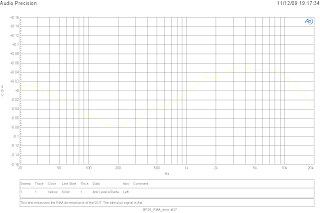next up in the curves is RIAA error. Without much introduction here are the curves (explanation to follow)...

These curves explain the output of each preamplifier in comparison to a reference RIAA curve. The reference RIAA curve was created using an industry standard RIAA 45-point curve provided by Audio Precision. The RIAA curve is then made to reference the 1 kHz output voltage of the first device (Pass Labs XONO, in blue). The reference is then held constant against the other devices, to demonstrate the level output difference as well as the curve disparity.
Much of the steep increases in both the Manley Steelhead and GSP Jazz Club + Elevator can be seen as the result of settling noise from variability in the AP. While this method of RIAA error does not seem to be exactly the same as the one Mr. Atkinson uses in Stereophile, it seems to be a reasonable assessment of the distance from a standard RIAA curve. However, as the measure seems better taken from comparing the freq response to a curve which is normalized to the standard output for a given device under test, the next graphs for MM will be plotted individually. The graph in this post however serves to demonstrate not only the RIAA error, but also the level differences between devices.




